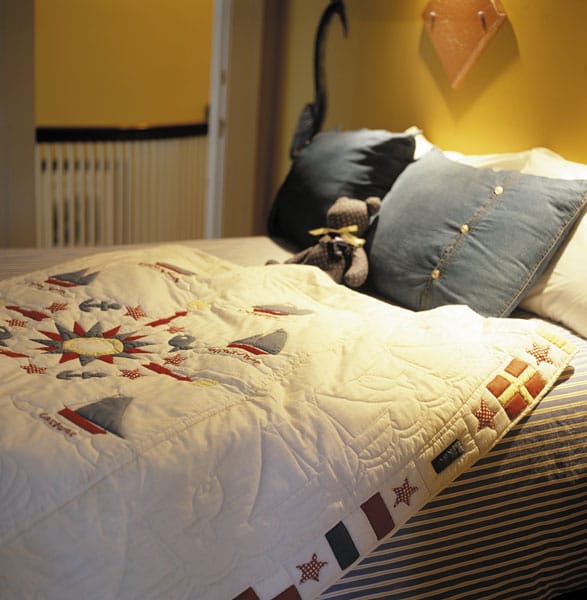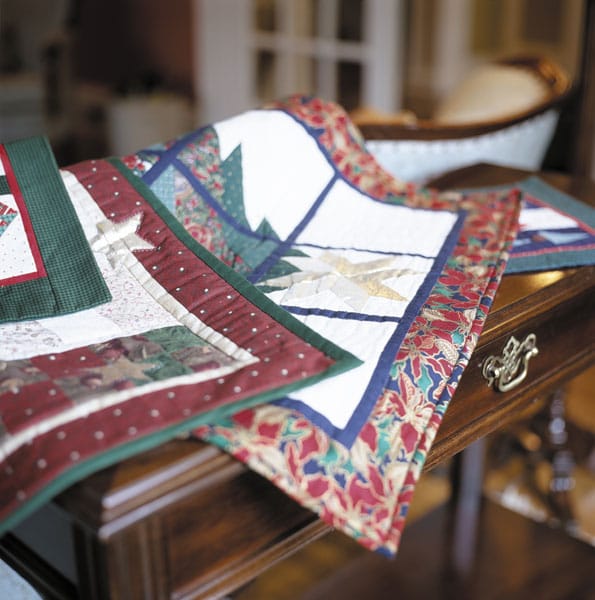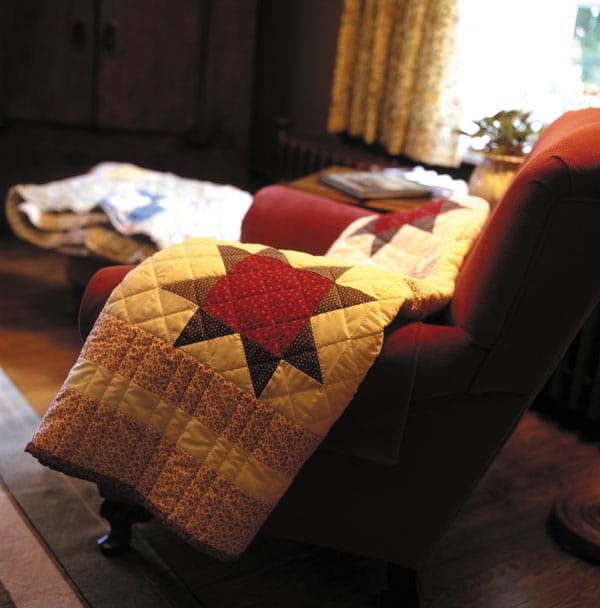Hand-stitched pieces of history invite you to snuggle in
On cold, stormy nights when a nor'easter noisily groans its haunted song at your door, they can protect you from bad dreams and, according to some little folk, even from monsters. To snuggle deep under the protective warmth, well, one just knows nothing bad can happen. Never did, so it never will.
When we were children, quilts easily metamorphosed into super-hero capes, Arabian desert tents, club hideouts away from our brothers, princess ball gowns, armor and warm hugs. They wiped the blood from skinned knees and dried our tears. As adults, we can appreciate their design, their beauty and craftsmanship, but nothing else really changes too much; more than anything else, it's still the wonderful sense of comfort and warmth that matters most.
What feels better on a cold night than snuggling under a warm quilt while reading with your children? Unless it's that moment when you finally have time to curl up on your own with a great book and a cat purring on your lap.
Here on the East Coast this feeling is nurtured by our rich history of quilt making. We're beginning to realize that these grandmothers of ours, who lovingly gave us these homespun treasures, were actually custodians of history. We have growing respect for quilts as historical documents and as personal expressions of those who stitched them.
"Quilts offer wonderful histories of our communities," says Barb Robson, founder of the Nova Scotia Heritage Quilt Project. "And it's extremely important to document the stories and the women's history." Many of the older quilts, like signature quilts or autographed quilts, will tell different stories from a particular community, "like the leaving of a minister," she says. Individual quilts can also tell a tale. One recently discovered Red Work (red embroidery on white) quietly reveals the frustration of a young farmwife, with a new and rather large extended family. "Embroidered amongst beautiful flowers and fairies were the words-'I slept and dreamt that life was beauty. I woke and found that life was duty.' Obviously all this young woman saw in front of her was work, work, work.

The Quilt Project, originally funded by the Mayflower Quilters Guild, documents older quilts in the province. With just over 1,100 included now, it records any history the owner may have, the size, pattern, techniques used, condition, kinds of fabrics and any history of the maker. "And every quilt is special to us, whether tattered or torn," says Barb who lives in Fox Point, NS. "Our only criteria really is that it was made before 1970. And it doesn't matter if it was made somewhere else." Collections are being recorded in most every province and across the United States so that people can share information and learn more about the histories. "It's really nice to be able to find out where Nova Scotia quilts are going, for example, or where they have gone in the past," she adds.
Quilts recorded in Nova Scotia go back as far as the mid-1800s. "We have a beautiful one from the Western Shore that is hand-woven cotton, hand-dyed, in navy blues and white. We have autographed, or signature quilts, that tell histories from particular communities. Usually they were done as fundraisers where you would pay so much to put your name on it. A lot of these that we have seen are in incredible shape.
"Quilters today obviously do it for the love of it. It takes anywhere from 300 to 500 hours to make a quilt and you're never really paid for what you do. It's really slave labour. But, although quilts were a necessity 100 years ago, with many it's not hard to tell that the quilters loved their work then as well," she said. "The beauty speaks for itself."
Quilting has always been an ingenious way of recycling fabric remnants. Old or worn clothes or furnishings were cut into patches and rejoined to make warm quilts for the home. The more controlled pattern work we recognize today became commonplace during the 17th and 18th centuries. "Quilts were something we just had to have," says 84-year-old Norma Spearing of Selma, NS. "Mom made them out of whatever she had. I can remember her dying flour bags, which was very common, or buying cotton at the Freize and Roy General store in Maitland, or from the Eaton's catalogue.
"Most of her quilts were just nine-patch," she adds, "nothing really fancy when we were young. I remember her using patterns such as Drunkard's Path and the Philadelphia Pavement. We did a lot of quilting for something to do, really. We didn't have television to look at then. You either pieced quilts or knit. Quilting bees were held in all the communities. Here in Selma, the Ladies Aid at the church used to have quilting bees in the afternoons. I used to go, I suppose, right after school, starting when I was about 12 or 13. Those quilts would be sold to raise money for the church. Quite often we would have orders from people who had moved away and gone to live somewhere in the United States. They said they couldn't ever get quilts as nice there as in the Maritimes."

Known in the local communities for her beautiful quilts, Mrs. Spearing says her favourite pattern is the Star of Bethlehem. Some of her more recent pieces, including a spectacular Star of Bethlehem done in rose colors, were displayed at a quilt show during Launch Day festivities in the community of Maitland. "I guess I couldn't begin to tell you how many quilts I've made over the years and given to my family," she says with a smile, "but for the amount I've done, I sure don't have much to show for it."
This is true for many. Most women claim quilting is a joy to be shared, a way to provide for the greater good while producing something that is also pleasurable for the maker. "It absolutely comes from the heart," says quilter Dianne Gamblin of Labrador City. "It's comfort for your soul and when you finish it, it's such a good feeling."
"I've always been fascinated by quilts. Ever since I was a little girl visiting my Aunt Mimi or my Granddad Allison's lady-friend, Florence, in the summers in Nova Scotia, and seeing their quilts. One in particular was made of velvet and was on a day-bed at Granddad's. I can remember always rubbing it," she says. "So, for me, a big part is just that I love having them around. The homey, warm fuzzy feeling they bring; the memories of good times of your childhood."
Although she collects antique quilts, like many quilters, most that she has made have been given away to family and friends. But, she says, "there's nothing more comforting than working on a quilt when it's 40? below.
"Quilting has a long and rich history in Atlantic Canada, and has always survived. This is true in our family and I think, thankfully, that creativity runs in the blood. It's great just to be able to sit back and relax and let your mind wander, and imagine what you might be able to come up with." Most of the quilts Dianne makes feature traditional patterns (the Dresden Plate is her favourite). She believes they all tell a story. Bits and pieces of fabric that may have been articles of clothing belonging to her now grown children, or swatches that may have gone into another quilt, record her family history.
An ancient art, quilts were often made by Atlantic Canadians to celebrate marriages, to welcome new babies and to honour friends. They can be a record of community history or a symbol of remembrance. Quilting guilds and quilting parties were, and are still, very strong here.

Julia LeClair belongs to a quilting co-op of about 15 in Tignish, PEI, and a quilting guild of about 25 in O'Leary. "It's always a learning experience," she says. The groups formed to promote quilting in the West Prince County area because there were so many good quilters already who could teach new members. Like quilting bees of years ago, quilting was something the women were comfortable doing and it was a "chance to get them out."
This past summer, the Tignish group rented a bus and travelled to Lunenburg, NS, to see the famous quilts from that area. "There were 13 of us that went," she says. "We had so much fun, and there was just so much to see. These groups are such a great thing for us to have."
She says like many Atlantic Canadian women, quilting was "just something you grew up with." She enjoys piecing the quilts most. The Bargello (a quilt using 11 different fabrics with very small pieces), for example, "gives you a huge sense of accomplishment when you're finished. It's beautiful and although it's a lot of work, I just love doing it. When you are finished with this quilt you just stand back and say, "Boy, did I really do that?"
Some members of Halifax's Mayflower group, including Karen Anderson, can understand that feeling. Last year, they bravely took a close look at the artistry of crazy quilts. They made wall hangings with lush fabrics, various embroidery stitches, ribbons, and notions. It was meant as a lesson in the complexities of traditional Victorian crazy quilt construction. Many didn't think they would really like the end product. But the resulting opulent designs are completely charming.
"Wall hangings are my favourite thing to do actually," says the Halifax family doctor. "I like a combination of piecing and appliqued work. And I tend to work seasonally. So, every fall I work on one with a fall theme. In November, I'll start working on wall hangings for Christmas gifts, and then in January I may tackle a big, bed quilt.
"I usually have about three projects on the go at one time, and this is pretty typical for quilters. We meet regularly with the group and work on individual projects, or work on a project as a small group. These quilts are often donated to places like Bryony House (a Halifax shelter for women leaving abusive relationships) or the Red Cross."

They enjoy trying to promote the craft and educate people about the history. "We talked to a group of Grade 3 children one year about quilting, and tried to impress upon them how long it takes to actually make them. Afterward, we asked them if they could guess how long it might take, and one little guy said '20 years'," she laughs.
Karen learned to quilt when she was about 16-years-old thanks to an elderly neighbour in Rexton, NB. "She went to church and quilted," she said. "It was basically all she did." The blue and white scrap quilt she made with this woman's help, helped her through university, she claims: "It was definitely my little piece of home. But I didn't pick up quilting again until I was 26, and I've been addicted ever since."
Eleanor Scott of South Tetagouche, near Bathurst, NB, has seen it before. "Quilting is actually kind of hard to explain to everyone. For most women involved, it becomes an absolute passion. It gets in the blood."
Eleanor teaches quilting and material dyeing classes to people ages eight-to-80, and says, although quilting "never, ever disappeared in Atlantic Canada," she is finding a strong resurgence in her area. "It's incredible to me all the young people who are learning to quilt right now. We have a lot who are between the ages of 25 and 40, but we're also getting the children. Last year our eight-year-olds made String of Pearls lap quilts. I think this is just great to see."
"Traditionally in Atlantic Canada, the skill of quilt making was passed down from generation to generation. But today it's a little bit different. Many of the young women coming for lessons are making works of art, really, as opposed to scrap quilts," she says. "But they are still being thrown across beds and are being used."
Halifax artist Marilyn Turner matter-of-factly says she took up quilting for another reason. With young children at home "and my husband in the navy and gone a lot, I just wanted to get out and talk to someone older than four." She started taking quilting courses in 1974 and, over the years, her quilts have been displayed in galleries across Canada and the United States. "I became a night school junky," she says. "My first course in quilting was from Ruth Chisholm, who is an extremely talented Nova Scotia woman, and who has been with the Mayflower group since its beginning. She really encouraged me, so I started out making a lot of pillows. My first finished quilt was a Dresden Plate. "Soon after, I took a 10-week workshop from Verlé Harrop at the Nova Scotia Centre for Craft and Design. She really let me know that I could do a lot of stuff on my own. It started out as a basic quilting course, but Verlé was off the wall," she said. "She was throwing everything at us and I was ready. Since then I've been going to Quilt Canada workshops continually."
As the Nova Scotia representative of the Canadian Quilters' Association, it is Turner's job to help make quilting better known. Upon entering Turner's Halifax home, it's obvious an artist/quilter lives within. Wall hangings, including some full-size quilts, grace most walls. Quilts are on the beds. Her basement is set up like an artist's studio where she dyes materials, and off the master bedroom is another studio where she designs her pieces and puts them together.
She also showcases the artistry elsewhere. She was commissioned to do three large panels that hang in the Atlantic School of Theology's St. Columba's chapel. They depict Psalm 133 "about how beautiful it is for men to live together as brothers," she says. The middle panel is 100 inches in length by 90 inches in width. The two side panels are 100 inches in length and 60 inches in width. Another wall hanging that showed at Quilt Canada in Vancouver in 1993, and then was invited to show at the University of Arizona in Flagstaff, is called Guppy's Guppies. It was made for her father, Albert Lionais of Sydney ("my children called him Guppy"). Although her quilts are truly works of art, she is quick to admit they share a common thread with any quilt made in Atlantic Canada. That is because quilts are proud gifts of love, eloquent testaments of faith and grand expressions of individual artistry.
Quilts speak of days gone by, of shared experiences, of loving labour, visions of the future and the joy of living. And they may even help protect against monsters on cold, wintry nights.
In 1884-85 the crazy quilt was the reigning fad. It was celebrated in stories and poems; imitated in printed cotton; depicted on trade cards; promoted by silk manufacturers and women's magazines; and exhibited everywhere in quilt displays.
Part of the reason for this mania lay in the fact that crazy quilts were scrap projects-something made from nothing. During this late-Victorian time frugality was as much admired as it was necessary. Women's magazines spread the idea that fabric scraps need not be thrown out. Instead, they suggested that homemakers use leftover bits of fabric (silks, ends of ribbons, discarded flounces, babies' sashes, gentlemen's neckties and other trims, braids and beads) to make crazy quilts. The craze lasted until about 1900 when the quilt was suddenly almost scorned as being old-fashion. Many were packed away. Many Atlantic Canadians might find hidden examples of the complex crazy quilt in grandmother's cedar chests.
In 1977, the Women's Institute of New Brunswick published a book entitled The New Brunswick Pieced Quilt Patterns. "This included patterns that had been passed down from generation to generation in New Brunswick, and patterns that were recorded in no other books. It includes the history and line drawings and patterns to scale," says Eleanor Scott of South Tetagouche. "We're very fortunate to have it." Some of the patterns include the more common Pinwheel and Churn Dash, and the less common L'Etoile, Le Papillon, Pot En Fleurs, and Jemseg Dahlia. Patterns were also obtained years ago through the Family Herald, Maritime Farmer, Evangeline Quilting Column, and "everyday the Fredericton Gleaner would have a quilt patch," she added.
Quilts created by Lillian Hennigar, Mildred Densmore, Karen Anderson, Norma Spearing and Susan Dunn
